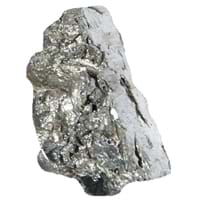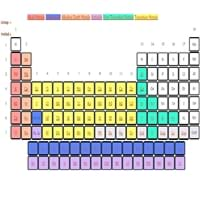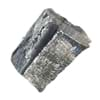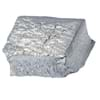Ytterbium vs Berkelium
Periodic Table
Symbol
Yb
Bk
Group Number
Not Available
Not Available
Period Number
6
7
Block
f block
f block
Element Family
Lanthanide
Actinide
CAS Number
7440644
26
7440406
99+
Space Group Name
Fm_ 3m
P63/mmc
Space Group Number
225.00
2
194.00
5
Facts
Interesting Facts
- Ytterbium metal oxidizes rapidly if exposed to air.
- Ytterbium metal can dissolve quickly in Mineral acid.
- X-ray Diffraction- different compounds of Berkelium metals are identified using it.
- Commercial uses of Berkelium metal are not yet discovered.
Sources
Found in Minerals, Mining, Ores of Minerals
Bombarding Americium with Alpha Particles.
History
Who Discovered
Jean Charles Galissard de Marignac
Lawrence Berkeley National Laboratory
Discovery
In 1878
In 1949
Abundance
Abundance In Universe
2 * 10-7 %
22
Not Available
Abundance In Sun
~0.0000001 %
26
~-9999 %
Abundance In Meteorites
0.00 %
36
Not Available
Abundance In Earth's Crust
0.00 %
33
Not Available
Abundance In Oceans
0.00 %
37
Not Available
Uses
Uses & Benefits
- Ytterbium metal is used in memory devices and tuneable laser.
- It is also used as industrial catalyst as the other catalysts are too toxic and polluting.
- This metal is very rare and has no commercial uses.
Industrial Uses
Automobile Industry, Chemical Industry
NA
Medical Uses
NA
NA
Other Uses
Alloys
NA
Biological Properties
Toxicity
Highly Toxic
Unknown
Present in Human Body
No
No
In Blood
Not Available
0.00 Blood/mg dm-3
37
In Bone
Not Available
0.00 p.p.m.
36
Physical Properties
Melting Point
824.00 °C
99+
986.00 °C
99+
Boiling Point
1,196.00 °C
99+
2,627.00 °C
40
Appearance
Physical State
Solid
Solid
Color
Silvery White
Silver
Luster
Metallic
Metallic
Hardness
Brinell Hardness
343.00 MPa
31
Not Available
Vickers Hardness
206.00 MPa
33
Not Available
Speed of Sound
1,590.00 m/s
99+
Not Available
Optical Properties
Allotropes
No
No
α Allotropes
Not Available
Not Available
β Allotropes
Not Available
Not Available
γ Allotropes
Not Available
Not Available
Chemical Properties
Chemical Formula
Yb
Bk
Isotopes
Known Isotopes
30
9
14
25
Electronegativity
Pauling Electronegativity
Not Available
1.30
32
Allred Rochow Electronegativity
1.06
33
1.20
27
Allen Electronegativity
Not Available
2.70
1
Electropositivity
Pauling Electropositivity
Not Available
2.70
22
Ionization Energies
1st Energy Level
603.40 kJ/mol
99+
601.00 kJ/mol
99+
2nd Energy Level
1,174.80 kJ/mol
99+
1,186.00 kJ/mol
99+
3rd Energy Level
2,417.00 kJ/mol
99+
2,152.00 kJ/mol
99+
4th Energy Level
4,203.00 kJ/mol
31
3,434.00 kJ/mol
99+
Electrochemical Equivalent
2.15 g/amp-hr
25
3.07 g/amp-hr
16
Electron Work Function
Not Available
Not Available
Other Chemical Properties
Ionization, Radioactive Isotopes, Solubility
Ionization, Radioactive Isotopes, Radioactivity
Atomic Properties
Atomic Number
70
99+
97
21
Electron Configuration
[Xe] 4f14 6s2
[Rn] 5f9 7s2
Crystal Structure
Face Centered Cubic (FCC)
Double Hexagonal Close Packed (DHCP)
Crystal Lattice
FCC-Crystal-Structure-of-Ytterbium.jpg#100
DHCP-Crystal-Structure-of-Berkelium.jpg#100
Atom
Number of Protons
70
99+
97
21
Number of Neutrons
103
31
150
11
Number of Electrons
70
99+
97
21
Radius of an Atom
Atomic Radius
176.00 pm
18
170.00 pm
22
Covalent Radius
187.00 pm
20
Not Available
Van der Waals Radius
242.00 pm
12
Not Available
Atomic Weight
173.05 amu
99+
247.00 amu
18
Atomic Volume
24.79 cm3/mol
9
Not Available
Adjacent Atomic Numbers
Valence Electron Potential
50.30 (-eV)
27
45.50 (-eV)
36
Lattice Constant
548.47 pm
11
341.60 pm
99+
Lattice Angles
π/2, π/2, π/2
π/2, π/2, 2 π/3
Lattice C/A Ratio
Not Available
Not Available
Mechanical Properties
Density
Density At Room Temperature
6.90 g/cm3
99+
14.78 g/cm3
22
Density When Liquid (at m.p.)
6.21 g/cm3
99+
13.25 g/cm3
11
Tensile Strength
58.00 MPa
18
Not Available
Viscosity
Not Available
Not Available
Vapor Pressure
Elasticity properties
Shear Modulus
9.90 GPa
99+
Not Available
Bulk Modulus
30.50 GPa
39
Not Available
Young's Modulus
23.90 GPa
99+
Not Available
Poisson Ratio
0.21
33
Not Available
Other Mechanical Properties
Ductile, Malleable
NA
Magnetic Properties
Magnetic Characteristics
Specific Gravity
6.97
99+
14.00
14
Magnetic Ordering
Paramagnetic
Paramagnetic
Electrical Properties
Electrical Property
Conductor
Conductor
Resistivity
0.25 nΩ·m
99+
Not Available
Electrical Conductivity
0.04 106/cm Ω
38
Not Available
Electron Affinity
50.00 kJ/mol
21
Not Available
Thermal Properties
Specific Heat
0.15 J/(kg K)
36
Not Available
Molar Heat Capacity
26.74 J/mol·K
25
Not Available
Thermal Conductivity
38.50 W/m·K
35
10.00 W/m·K
99+
Critical Temperature
26.30 K
7
Not Available
Thermal Expansion
26.30 µm/(m·K)
14
Not Available
Enthalpy
Enthalpy of Vaporization
128.90 kJ/mol
99+
Not Available
Enthalpy of Fusion
7.66 kJ/mol
99+
Not Available
Enthalpy of Atomization
180.00 kJ/mol
99+
Not Available
Standard Molar Entropy
59.90 J/mol.K
21
Not Available
|
||
|
||
|












